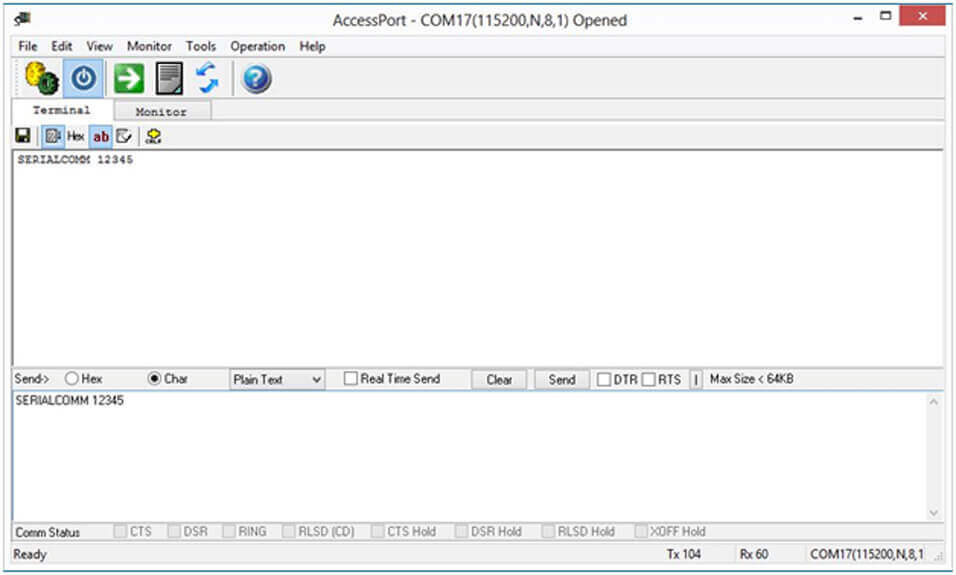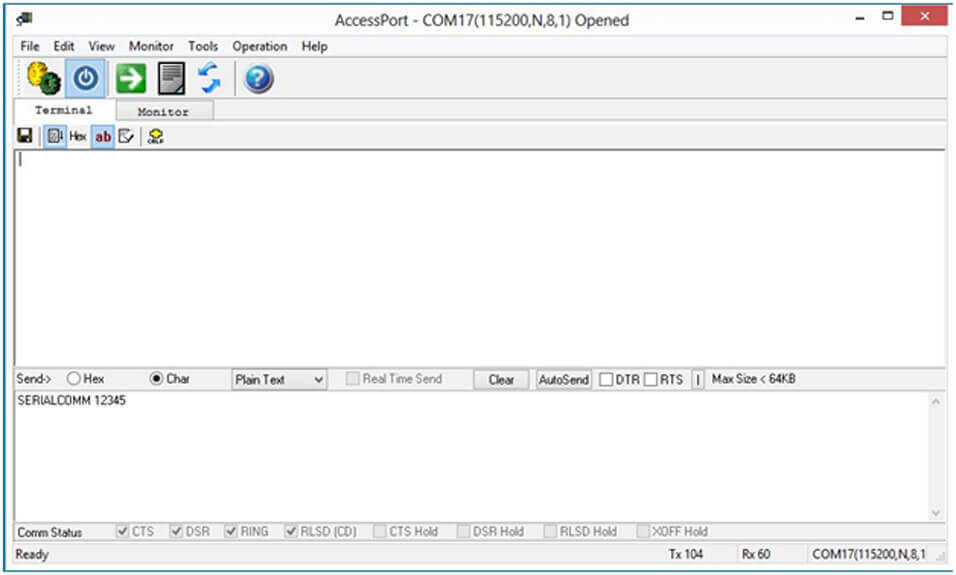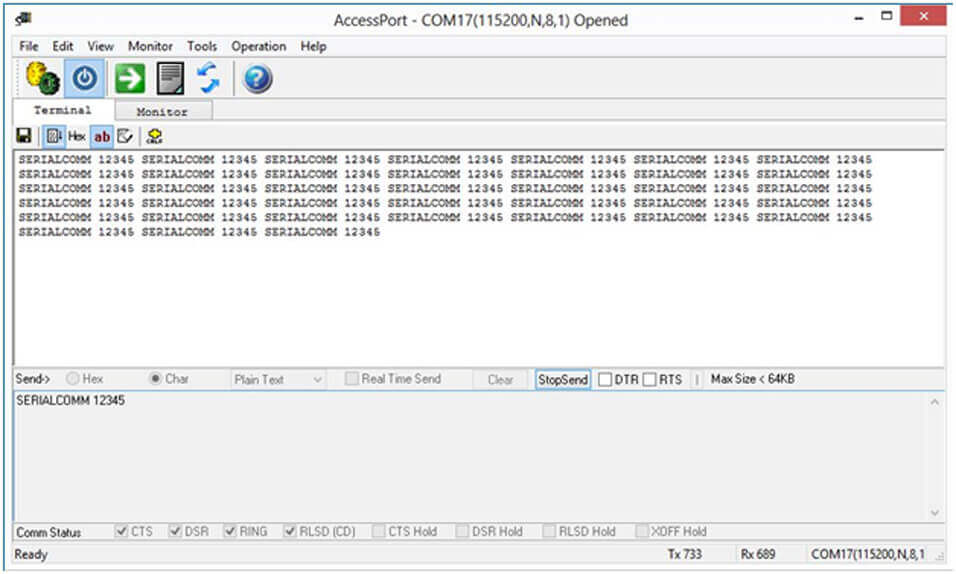ACCESSPORT USER MANUAL
TABLE OF CONTENTS
- 1 SCOPE
- 2 OVERVIEW
- 3 FEATURES
- 4 INSTALLATION OF THE ACCESSPORT SOFTWARE
- 5 ACCESSPORT USER INTERFACE
- 6 APPLICATION EXAMPLES
1 SCOPE
This user manual describes the AccessPortTM Advanced Serial Port Terminal / Monitor / Debugger Freeware (AccessPort) authored by SUDT Studio to the extent of optional operation with SerialCommTM products. AccessPort is rich with serial debugging functions and not all of its functions will be covered in this manual. The AccessPort is a Microsoft Windows-based serial debugging tool used in conjunction with the hosted PC/laptop COM serial ports. This document describes the latest version of the AccessPort: Version V1.37. The examples used in this document will be presented using the Microsoft Windows 8 operating system.
2 OVERVIEW
AccessPort is an advanced serial terminal, monitor, simulation and data analysis tool that can be used to configure and control serial devices as well as log, view, analyze, or automate serial communication. SerialCommTM offers a number of data conversion products; primarily RS232 to RS485/RS422/TTL/Ethernet/Fiber Optic converters for your data conversion needs. AccessPortTM Advanced Serial Port Debugger Freeware is an optional robust serial terminal/monitor software. It has a simple user interface that can be used to control, monitor, test, and debug RS232/RS485/RS422/TTL/Ethernet/Fiber Optic data utilizing our serial products for serial data conversion. Although AccessPort is an advanced serial port terminal / monitoring tool with robust functionality while easy to use due to its simplistic user interface. It is used by technicians, engineers, software developers, as well asnovices for designing or debugging serial port-related projects.
AccessPort is a thoroughly tested, mature, and highly-stable product used worldwide by professional engineers, technicians and software developers. It is used as a development aid and debugging tool for RS232 / serial port related projects. Since it’s so easy to use witha “simple†user interface, this tool isa favorite amongst serial port novices.
The software supports Microsoft Windows 98, 2000, XP, Vista, Server 2003, 2008, 2013, Windows 7 32 bit and 64 bit and Windows 8 32 bit and 64 bit.
3 FEATURES
4 INSTALLATION OF THE ACCESSPORT SOFTWARE
The AccessPort Software should be installed on the host Windows based PC or laptop that has access to the serial port that will be controlled or monitored. The installation procedure is as follows:
5 ACCESSPORT USER INTERFACE
The AccessPort Software Interface has many advanced features yet simple to use. It has two main functions 1) Terminal Mode and 2) Monitor Mode. By selecting the Terminal tab the following screen will appear. SEE FIGURE 5.1

FIGURE 5.1
By selecting the Monitor tab the following screen will appear. SEE FIGURE 5.2

FIGURE 5.2
5.1 TERMINAL MODE
We will be documenting the Terminal Mode interface of AccessPort and not the Monitor Mode interface for simplicity. We will be using the Terminal Mode to control, monitor, debug, and test the associated serial ports and SerialComm conversion products connected to the serial ports. SEE FIGURE 5.3

FIGURE 5.3
The Terminal Mode Interface if divided into 6 operational sections:
1) Upper COM port status bar. SEE FIGURE 5.4

FIGURE 5.4
2) Upper menu bar. SEE FIGURE 5.5

FIGURE 5.5
3) Main functions toolbar. SEE FIGURE 5.6
FIGURE 5.5
4) Input display box and control toolbar. SEE FIGURE 5.7

FIGURE 5.7
5) Output data box and control and status toolbar. SEE FIGURE 5.8

FIGURE 5.8
6) Bottom status bar. SEE FIGURE 5.9

FIGURE 5.9
5.1.1 UPPER COM PORT STATUS BAR
This status bar shows which COM port is used and the selected attributes. This status bar will also tell you whether the port is opened or closed. SEE FIGURE 5.10

FIGURE 5.10
5.1.2.1 FILE CATEGORY
The “File†Category saves data and settings to a file, exports data and exits the program. The “File†Category has the “Saveâ€, “Save Asâ€, “Export As HexDumpâ€, and“Exit†options. SEE FIGURE 5.12

FIGURE 5.12
5.1.2.1.1 SAVE
Saves the AccessPort data and settings.
5.1.2.1.2 SAVE AS
Saves the AccessPort data and settings to a specified file name.
5.1.2.1.3 EXPORT AS HEXDUMP
The data from AccessPort can be exported to a file in Hexadecimal format. Specify the start location and stop location. There are some other parameters you can choose. The Hexadecimal formatted data can be exported to the clipboard or a file by choosing the appropriate option. SEE FIGURE 5.13

FIGURE 5.13
5.1.2.1.4 EXIT
Exits the AccessPort program.
5.1.2.2 EDIT CATEGORY
The “Edit†Category can undo a function, cut, paste and delete and select data in the output display box. The “Edit†Category has the “Undoâ€, “Cutâ€, “Copyâ€, “Pasteâ€, “Deleteâ€, and “Select All†options. SEE FIGURE5.14

FIGURE 5.14
5.1.2.2.1 UNDO
Undo a previous function.
5.1.2.2.2 CUT
Cuts input display data.
5.1.2.2.3 COPY
Copies input display data.
5.1.2.2.4 PASTE
Pastes input display data.
5.1.2.2.5 DELETE
Deletes input display data.
5.1.2.2.6 SELECT ALL
Selects all of the input display data.
5.1.2.3 VIEW CATEGORY
These options control viewing of AccessPort. It allows for the selecting of unselecting view sections of AccessPort for display. SEE FIGURE 5.15

FIGURE 5.15
5.1.2.3.1 TOOLBAR
Turns on and off the Icons toolbar.
5.1.2.3.2 STATUS BAR
Turns on and off the bottom status bar.
5.1.2.3.3 SENDING BAR
Turns on and off the output data box section.
5.1.2.3.4 DISPLAY BAR
Turns on and off the input display box section.
5.1.2.3.5 LANGUAGE
Changes the language of AccessPort. The available options are English, Chinese (Simplified), Chinese (Traditional), and Russian.
5.1.2.4 MONITOR CATEGORY
The “Monitor†category has functions to control the Monitor mode. The “Monitor†category has the “Clear Allâ€, “Auto Scrollâ€, “Show Hexâ€, “Capture Eventsâ€, “Start Monitorâ€, “Stop Monitorâ€, and “Ports†options. SEE FIGURE 5.16

FIGURE 5.16
5.1.2.4.1 CLEAR ALL
Clears all data.
5.1.2.4.2 AUTO SCROLL
Turns on or off the Auto Scroll function.
5.1.2.4.3 SHOW HEX
Turns on or off the display of HEX (Hexadecimal).
5.1.2.4.4 CAPTURE EVENTS
Turns on or off the ability to captures events.
5.1.2.4.5 START MONITOR
Starts the monitor.
5.1.2.4.6 STOPS MONITOR
Stops the monitor.
5.1.2.4.7 PORTS
Selects the ports to monitor.
5.1.2.5 TOOLS CATEGORY
The “Tools†category is a collection of some useful software tools. The “Tools†category has the “Port Switchâ€, “Transfer Fileâ€, “Configurationâ€, “Start Debugâ€, “Select Fontâ€, and “Background Color†menu options. SEE FIGURE 5.17

FIGURE 5.17
5.1.2.5.1 PORT SWITCH
Switches ports and toggles the “Comm†status on the bottom of the display.
5.1.2.5.2 TRANSFER FILE
Transfers a file. Select the file you want to transfer and press the “SEND†button. SEE FIGURE 5.18

FIGURE 5.18
5.1.2.5.3 CONFIGURATION
Configures the COM port and serial settings. There is a collection of six menu screens: “Generalâ€, “Event Controlâ€, “Flow Controlâ€, Timeout Control†and “Monitor Controlâ€. The default view is the “General†configuration menu option. SEE FIGURE 5.19
5.1.2.5.3.1GENERAL
The “General†configuration menu option contains the main serial port settings and configuration. In order to operate AccessPort the COM port being used must be configured and opened. Selecting the presented required settings and selecting “OK†opens the COM port. The General settings are divided into six sections: “Custom Baud Rateâ€, “Serial Port Settingsâ€, “Send Displayâ€, “Receive Displayâ€, “AutoSendâ€, and “Advancedâ€. SEE FIGURE 5.19
5.1.2.5.3.1.1 CUSTOM BAUD RATE
The “Custom Baud Rate†selects the baud rate data is being transmitted and received. The baud rate is the speed in which the data is be transmitted. The supported baud rates range from 110 baud to 256,000 baud. Standard baud rates are available from the dropdown menu in the Serial Port Settings section. Custom baud rates can be also entered by checking the “Enable†option and typing the custom baud rate. SEE FIGURE 5.19
5.1.2.5.3.1.2 SERIAL PORT SETTINGS
The “Serial Port Settings†allow the COM Port, Baud Rate, Parity Bit, Data Bit, and Stop Bit to be configured. SEE FIGURE 5.19
5.1.2.5.3.1.3 SEND DISPLAY
The “Send Display†selects either Char Format (ASCII Character) or Hex Format (Hexadecimal Number) for the output data that will be sent. SEE FIGURE 5.19
5.1.2.5.3.1.4 RECEIVE DISPLAY
The “Received Display†selects either Char Format (ASCII Character) or Hex Format (Hexadecimal Number) for the input data display that will be received. SEE FIGURE 5.19
5.1.2.5.3.1.5 AUTOSEND
The “AutoSend†allows the output data to be continuously transmitted with a delay in ms at the end of each transmit specified by the Cycle value. To enable “AutoSend†check the Enable AutoSend box. SEE FIGURE 5.19
5.1.2.5.3.1.6 ADVANCED
The “Advanced†can automatically open a port as soon as the application starts, or notify of any available updates. SEE FIGURE 5.19

FIGURE 5.19
5.1.2.5.3.2 EVENT CONTROL
“Event Control†sets trigger events, if required. Check the “Event Control Settings†options you want to trigger an event. SEE FIGURE 5.20

FIGURE 5.20
5.1.2.5.3.3 FLOW CONTROL
The “Flow Control†settings can be used if flow control is necessary. Flow control is not used by default. You can select whether NONE, RTS/CTS (Hardware), DTR/DSR (Hardware), or XOFF/XON (Software) flow control will be used. Hardware and Software Flow control settings can be configured with the “Hardware Control Settings†or “Software Control Settingsâ€. SEE FIGURE 5.21

FIGURE 5.21
5.1.2.5.3.4 TIMEOUT CONTROL
Input and Output timeout control settings are configured here using the “Read Timeout†settings and “Write Timeout†settings. SEE FIGURE 5.22

FIGURE 5.22
5.1.2.5.3.5 MONITOR CONTROL
The “Monitor†settings allow the maximum data buffer to be defined. SEE FIGURE 5.23

FIGURE 5.23
5.1.2.5.4 START DEBUG
This is an advanced feature that will not be covered in the document. The dropdown looks like this. SEE FIGURE 5.24

FIGURE 5.24
5.1.2.5.5 SELECT FONT
Changes the font, text attributes and color of the input display data.
5.1.2.5.6 BACKGROUND COLOR
Changes the background color of the input display box.
5.1.2.6 OPERATION CATEGORY
The “Operation†category is a collection of operational functions. The “Operation†category has the “Send Dataâ€, “Clear Outputâ€, “Output Formatâ€, “Reset Counterâ€, “Clear Inputâ€, and “Display Format†menu options. SEE FIGURE 5.25

FIGURE 5.25
5.1.2.6.1 SEND DATA
Transmits data from the output data box. Same as clicking on Send/AutoSend.
5.1.2.6.2 CLEAR OUTPUT
Clears the data from the output data box.
5.1.2.6.3 OUTPUT FORMAT
Toggles the data representation of the output data box to either ASCII characters or Hexadecimal format.
5.1.2.6.4 RESET COUNTER
The bottom status bar displays the TX count and RX count. These counts represent the number of bytes transmitted and received. Reset Counter resets these counts to zero.
5.1.2.6.5 CLEAR INPUT
Clears the data input display box.
5.1.2.6.6 DISPLAY FORMAT
Toggles the data representation of the input display box to either ASCII characters or Hexadecimal format.
5.1.2.7 HELP CATEGORY
The “Help†category is a collection of help related operations. The “Help†category has the “Homepageâ€, “Check Newest Versionâ€, and “About AccessPort†menu options. SEE FIGURE 5.26
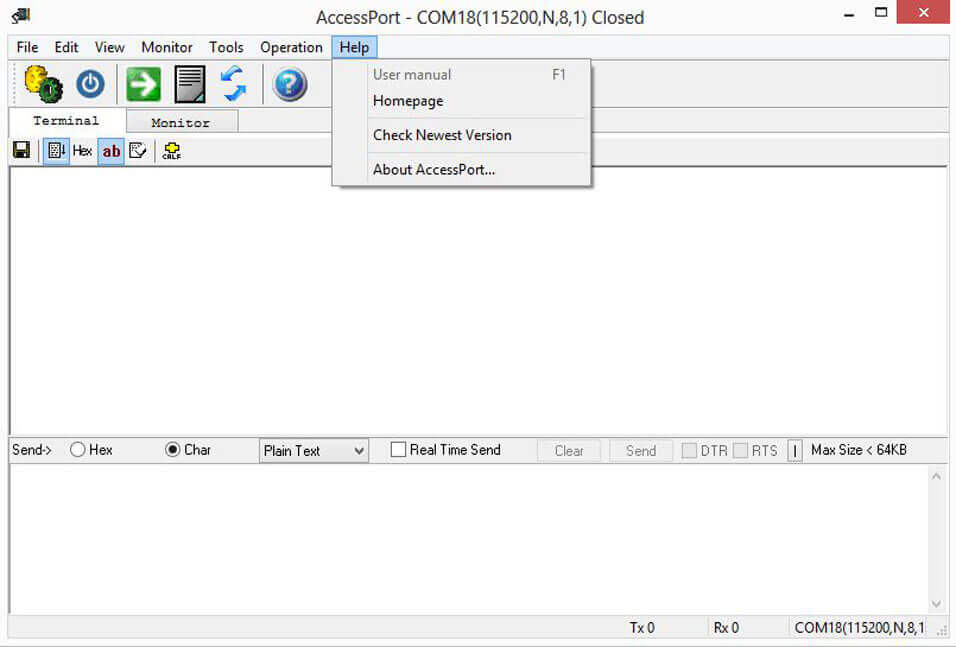
FIGURE 5.26
5.1.2.7.1 HOMEPAGE
Takes you the SUDT.com website.
5.1.2.7.2 CHECK NEWEST VERSION
Checks to see if this version of AccessPort is up-to-date.
5.1.2.7.3 ABOUT ACCESSPORT
Returns relevant information regarding AccessPort. The version and build numbers can be obtained from this page. SEE FIGURE 5.27

FIGURE 5.27
5.1.3 MAIN FUNCTIONS TOOLBAR
The graphic icon toolbar provides main function icons.
FIGURE 5.28
Initiates the serial port configuration. SEE SECTION 5.1.2.5.3
Switches ports. SEE SECTION 5.1.2.5.1
Transfers a file. SEE SECTION 5.1.2.5.2
Shows predefined data lists as well as echoes transmitted data to the input data box.
Resets the TX and RX counters. SEE SECTION 5.1.2.6.4
Displays “About SUDT AccessPort†screen. SEE SECTION 5.2.7.3
5.1.4 INPUT DISPLAY BOX AND INPUT DATA CONTROL TOOLBAR
The input display box is where the data that is received by AccessPort is displayed. SEE FIGURE 5.29

FIGURE 5.29
On top of the input display box is an icon toolbar with common data input functions. SEE FIGURE 5.30
FIGURE 5.30
Saves the input data to a specified file.
Pauses displaying data on the input data display.
Changes the input data display format to Hex (Hexadecimal).
Changes the input data display format to Char (ASCII Character).
Clears the input data display.
Adds carriage returns/line feeds to the input data display.
5.1.5 OUTPUT DATA BOX & OUTPUT DATA CONTROL TOOLBAR
The output input box is where the data to be transmitted is typed in. The toolbar on topallows you to input data in Hex or Char format, plain text or hex string format and in real time or not. The toolbar also has the SEND / AUTOSEND button. SEE FIGURE 5.31

FIGURE 5.31
5.1.6 BOTTOM STATUS BAR
The bottom status bar shows the handshaking and flow control indicators of the comm status. It also show the TX (transmit) and RX (receive) data counts and serial port settings. SEE FIGURE 5.32

FIGURE 5.32
5.2 MONITOR MODE
The Monitor mode interface will not be covered in this document.
6 APPLICATION EXAMPLES
Two application examples will be presented demonstrating how AccessPort can be used to test our products. The first application is a simple loopback test of a single serial port or serial device. The second application demonstrates the data communication between two serial ports or serial devices. In both examples the terminal modes will be used.
6.1 APPLICATION 1 â€"SINGLE SERIAL PORT LOOPBACK
A single port or device loopback test is a very useful way of determining whether a serial port, attached device, or converter is functioning properly. A loopback test can be performed on aserial RS232 port or device by connecting TX and RX (pins 2 and 3) together. A loopback test can only be performed on other full duplex (simultaneous bidirectional serial devices) protocols. By using our RS232 to RS422 converter, a loopback test on RS422 can be performed by connecting TX+ to RX+ and TX- to RX-. In addition, our RS232 to TTL converters can be looped back by connecting TX to RX. Our fiber optic converters can be looped back by connecting fiber in to fiber out. RS485 is half duplex and cannot be single converter loop back tested.
In this example we will be looping back our USB-232-2 USB to RS232 adapter by connecting TX to RX(pin 2 to pin 3) on the DB9 connector. We are using a USB to RS232 adapter because the computer we are using does not have a serial port. We will only need to open one instance of AccessPort since the looped back data transmitted will be received by the same port and be displayed in the output box of the same AccessPort.
6.2 APPLICATION 2 â€" SERIAL DATA COMMUNICATION
A good way to test data communication through two ports or two converters is performing a two converter loop back with two COM ports of the PC/laptop. Transmitting data from one COM port to other COM port using our converters is a useful test to determine whether the conversion protocol is functioning properly. A test can be performed on two serial RS232 ports by using a null modem adapter/cable in between the serial ports or using our converters as well. Data transfer between two RS485 converters can be performed to test half duplex RS485 with this test method. The same type of test can be used to also test RS422, TTL, Fiber Optic, and Ethernet using our RS232 converters. Some protocols are half duplex (transfer data in one direction a time) while others are full duplex (transfer data in both directions at the same time).
In this example, we will be using two USB-232-2 USB to RS232 adapters and two CON-422-PE9 RS232 to RS422 converters to communicate from one RS232 port to the other. We are using the USB to RS232 adapters because my PC does not have serial ports.SEE FIGURE 6.8

FIGURE 6.8
CONTROL PANEL→HARDWARE AND SOUND→DEVICE MANAGER→PORTS (COM & LPT)- SEE FIGURE 6.9
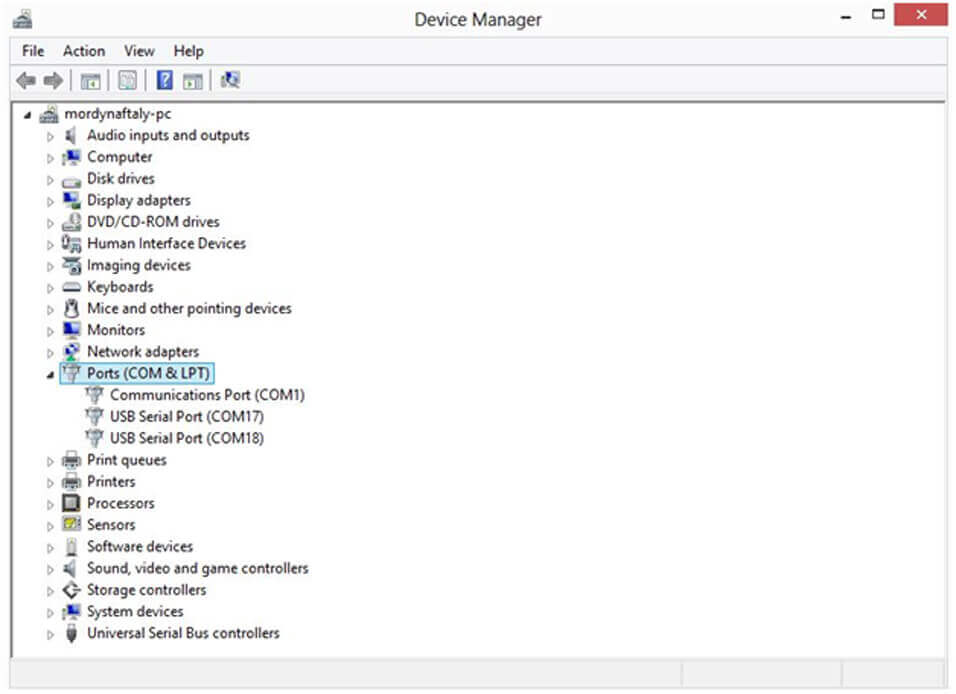
FIGURE 6.9

FIGURE 6.10

FIGURE 6.11

FIGURE 6.12

FIGURE 6.13

FIGURE 6.14

FIGURE 6.15
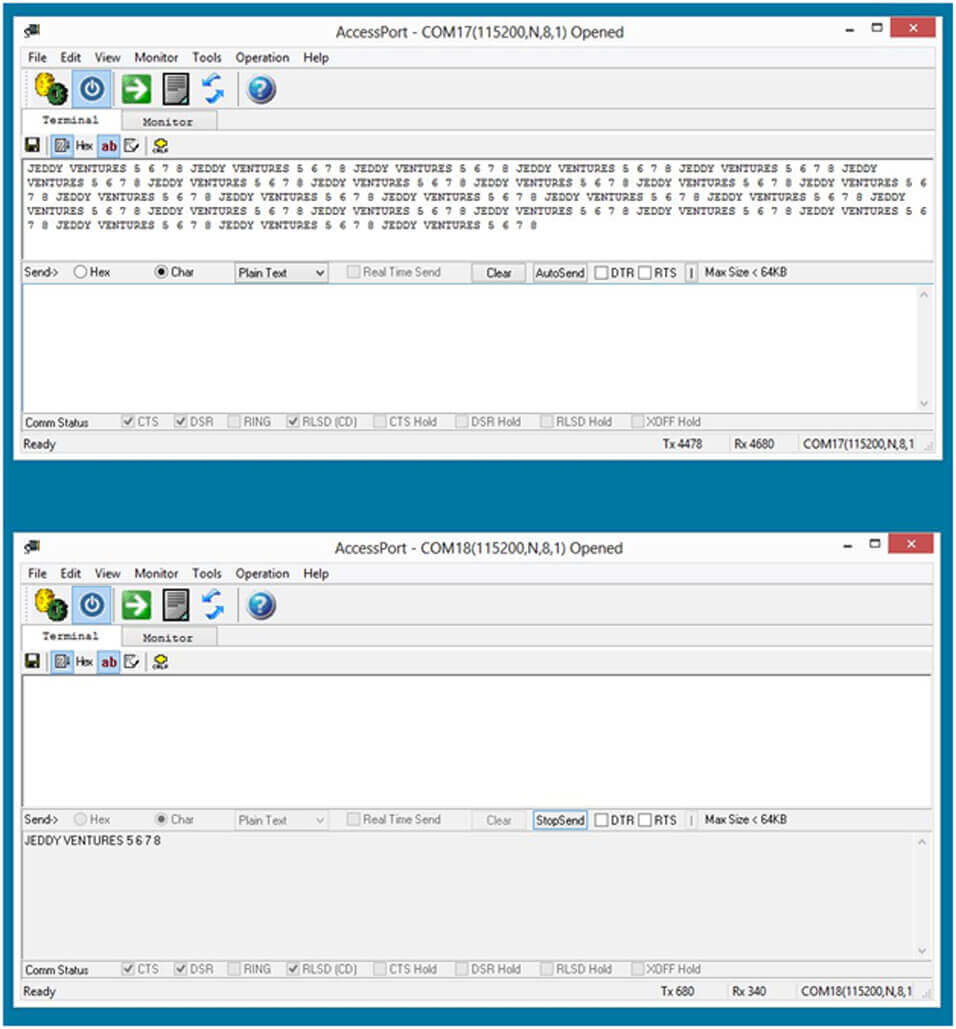
FIGURE 6.16








